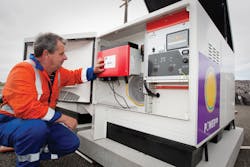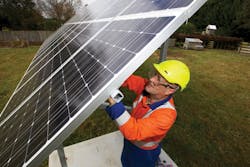The electricity network of Powerco, a distribution utility that supplies some 320,000 customers in the lower and central regions of New Zealand’s North Island, mainly consists of overhead lines totaling 30,000 km (18,641 miles). Much of the network covers remote hilly terrain where customer density is typically less than one customer per line kilometer, and the energy demand of individual customers is low.
The 11-kV lines have a service life of around 40 years. As the overhead lines age, the hard wood poles decay and split, and the crossarms break. The conductors, a combination of aluminum conductor steel reinforced (ACSR) and No. 8 steel wire, weaken as they corrode. Pasture converted to forestry presents further challenges for the overhead line reliability.
These factors affect supply reliability and create public safety hazards. Distance, trees and storms together with low populations and economics mean the overhead lines cannot supply remote customers with the same reliability of supply as customers in urban and commercial centers.
In New Zealand, distribution utilities have an obligation to continue to provide lines services to all existing pre-1993 consumers. To meet this obligation, the estimated cost of rebuilding the time-expired remote rural overhead lines throughout the country is estimated to be NZ$300 million.
Therefore, Powerco has developed a stand-alone power system (SAPS) that offers an economic alternative to rebuilding the aging overhead lines in remote areas. The utility’s SAPS allows the overhead lines to be decommissioned while electricity supply to customers is maintained at a lower cost than connection to the grid.
Powerco’s work with customers has confirmed they want a reliable supply of electrical energy not necessarily afforded by overhead lines. This being the case, the utility decided to prove the erection of overhead lines was not the sole, or always the best, way to supply energy needs and could result in significant savings.
Stand-Alone Power System
Powerco first commissioned the SAPS in 2008 as a pilot trial, supplying a wool shed and the shearer’s quarters. The results were used to help lobby the New Zealand government to allow for energy supplies that met customer needs without the need for a connection to an overhead line network. This pilot trial involved an expenditure of $70,000, which alleviated the need to spend around $200,000 for rebuilding the existing overhead line with a like-for-like configuration, the lowest-cost overhead line rebuilding option.
The supply regulations were updated in October 2010, permitting distribution utilities to meet their supply obligations from alternative sources to the overhead line network. Consequently, Powerco began work on its first combined stand-alone unit, which was installed at a remote sheep station in March 2011.
While many stand-alone electricity options were already on the market, they had several drawbacks for customers such as risk of interference, safety and inconvenience. Therefore, Powerco focused on creating a supply-on-demand product that would deliver electrical energy. The manufacturer awarded the SAPS supply contract has developed its own module, but Powerco added some additional features before the units were installed.
Prior to the trial, the supply of energy to the wool shed and small shearer’s dwelling was delivered by a 4-km (2.5-mile)-long single-phase spur from the main 11-kV feeder to an 11-kV/230-V transformer near the dwelling. The line, routed through rugged terrain, was due for a major refurbishment at a cost of around $200,000.
The SAPS, installed in a single day, included photovoltaic (PV) cells, a battery bank for energy storage, a diesel generator and a load management system. All the components, including site foundation pads and PV framing, were assembled at the Powerco depot. The modular unit was tested by supplying electricity for security lighting at the depot for six months to gain confidence in its performance and correct any design issues.
The operation was monitored for one year, with data analyzed to confirm whether the system met the requirements in terms of supply continuity, power quality, maintenance regimes and customer acceptability. The results were promising, with the PV panels in conjunction with batteries proving to be cost-effective and reliable for supplying energy at non-peak times.
The customer’s overall energy costs were lower than when connected to the distribution network, and the reliability of supply improved as SAPSs are not vulnerable to the supply interruptions that occur on long rural networks due to adverse weather conditions, tree contact and equipment failure.
Program Expansion
Powerco has now installed SAPSs at four sites, with five additional units targeted for this year. Another 12 sites are under investigation for possible installation. All the sites have different energy needs, ranging from wool sheds with high loads for short periods, single households with consistent daily load patterns and a radio tower. An islanded network with several households, wool sheds and pumps also has been assessed but, while technically achievable, has not yet been approved for SAPS installation because of the additional social, legal and commercial complexities of managing multiple customers.
The simpler, fully integrated SAPS solution allows customers to have a supply comparable to that received by a distribution network in addition to several other benefits. The SAPS has been designed to match or surpass the quality of supply from a distribution overhead line network supply at less cost. The modules in the SAPS are designed to allow a plug-and-play energy supply with no specialist skills required from the customer to operate or maintain the system. This makes it attractive to all electricity consumers, and it is now gaining interest from new remote customers.
Design Features
The fully integrated, self-managed power solution makes maximum use of local renewable energy — solar, wind and water — delivering electricity to storage banks, ready for distribution to workplaces and homes. The more renewables the customers add, the larger capacity they have and the less diesel fuel that is required for backup. This creates an element of customer empowerment on energy investments and energy bills.
The SAPS includes energy storage modules, load management (inverter) modules, scalable PV cells, potentially scalable micro-hydro generation, fossil fuel generators and the use of bottled liquefied petroleum gas (LPG) for stoves and water heating. Energy-efficient products for lighting, refrigerators and motive power as well as localized load control are used. The modules are designed to facilitate easy installation, commissioning and ongoing maintenance.
Satellite or mobile communications are used to monitor performance and indicate system failures. In effect, it covers many of the customer-side components and challenges of residential smart networks. Powerco seeks to optimize energy usage around peak times using the integration of renewables, management of localized generation components and localized peak load lopping on the site’s alternating-current (ac) grid.
Individual units have the capacity to store between 720 Ah and 1,100 Ah of energy, or approximately three to five times the daily electricity use of a reasonably energy-efficient home. Modules cater to the specific energy needs of each customer, without the need for specialized hybrid systems for each site, and scale can be achieved from installing two units and larger generation. The cost of installation is dependent on the capacity and design specification, but it is typically in the range of $30,000 to $80,000 — this
includes site works and a standard PV capacity of 1.2 kW. Other advantages of a modular system include improved reliability, scalability, ease of maintenance and remote monitoring.
The equipment is housed in a secured and controlled environment, offering several benefits beyond the confidence of full compliance in remotely located and inaccessible locations. This helps the energy storage module to keep batteries within their optimum temperature range, providing secondary containment of any leaks to protect the environment. In addition, the customer, stock or vermin are unable to interfere with the system or its controls, or risk harm from hot or electrical components.
Design Flexibility
The SAPS requirements depend on the site and load profile. Once the site load profile has been determined, the storage system can be sized and commissioned in the workshop before installation. A fossil fuel standby generator module may not be needed depending on the load requirement and availability of renewables on site.
Resizing is simple. The modules allow capacity increases to be achieved by replacing the energy storage unit with one of larger capacity. The PV module can have more panels fitted depending on the load profile (typically 1.2 kW for an uninhabited site or 4 kW to 10 kW for an inhabited site), and scale can be achieved by installing two energy storage and management units.
The SAPS performance can be checked remotely, with system failure alarms routed to maintenance personnel while low fuel alarms are routed to the customer. The modules all have the same configuration and equipment so technical support is relatively easy. This means a faulty module can be replaced and repaired at the workshop so outage times are minimized.
SAPS involving PVs and diesel generators are proving to be cost-effective and reliable alternatives to a grid connection for supplying some remote rural customers. The triggers for considering SAPS include the need to renew overhead lines that are excessively long and where it is difficult to access and supply individual or small numbers of customers. Another trigger is overhead lines that have many vegetation control requirements.
The costs and benefits are dependent on the profile of the load supplied, nature of the terrain, length of the overhead line and available alternative energy sources. Typically, overhead lines in excess of 2 km (1.2 miles) serving a single customer with transformer capacity of less than 15 kVA are worth considering for SAPS.
Powerco’s work has shown that a SAPS supplying one customer can have a net economic benefit if the length of the end-of-life overhead line it replaces is greater than 2 km. However, the break-even point is dependent on the customer’s load profile, the nature of the terrain and the options available for alternative energy.
Both customers and Powerco are benefiting from the SAPS. Customers are isolated from the risks to supply as a result of adverse weather, while the utility is reducing costs by eliminating the need to replace costly spans of remote overhead lines. Customers have been quick to praise the SAPS, as apart from refueling, they experience little difference from being connected to the distribution network.
Michael Whaley ([email protected]) has nearly 26 years of experience in the electricity industry and is now chief engineer at Powerco with responsibility for setting technical standards and policies, and arbitrating technical decisions. He has held various senior management roles at the utility over the past nine years. Whaley previously worked at an engineering and management consultancy, focusing on electricity planning, asset valuation and design assignments in New Zealand and internationally.
Ken Pattie ([email protected]) is Powerco’s western systems and performance engineer, having responsibility for monitoring the overall performance on Powerco’s high-voltage network. He has fulfilled a number of roles in the electrical industry over his 36-year career, including maintenance and construction work, fault work and 16 years of experience in network operations. Over the past 12 years with Powerco, Pattie has been involved with contract management and network planning.
Company mentioned:
Powerco| www.powerco.co.nz






